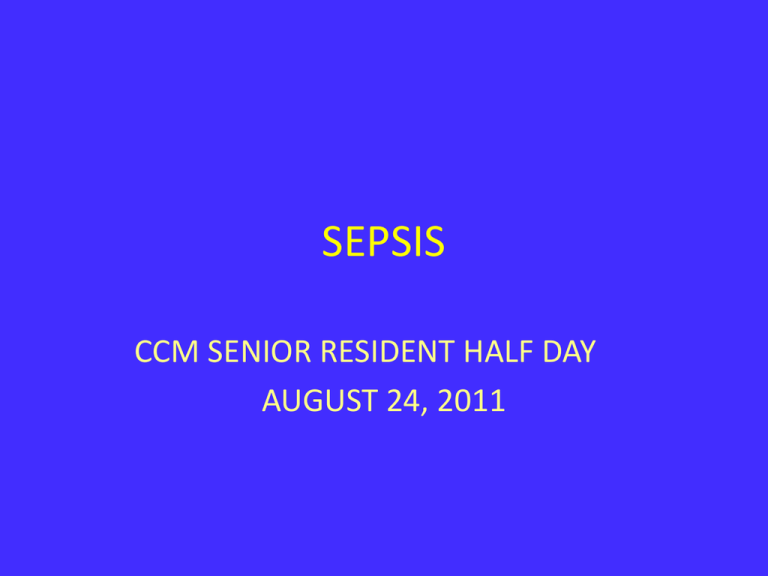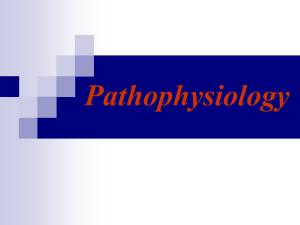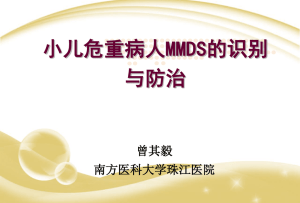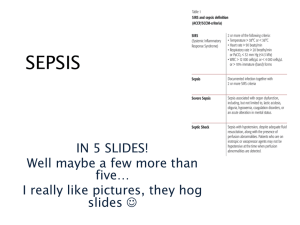
SEPSIS
CCM SENIOR RESIDENT HALF DAY
AUGUST 24, 2011
OUTLINE
•
•
•
•
DEFINITIONS
PATHOPHYSIOLOGY
TREATMENT
COMPLICATION
DEFINITION
• Evolving:
– Long history
– Sepsis: derived from Greek word for the
decomposition of animal or vegetable matter
– First used by Homer over 2700 yrs ago
– Over 100 yrs ago the link between bacteria and
systemic infection was first described. (Schottmueller,
AIM 1914)
DEFINITION
• Sepsis is a HOST RESPONSE to an invading organism and really
reflects that response as much if not more than the organism
• Sepsis Syndrome:
–
–
–
–
–
–
R. Bone 1989
Hypo or hyperthermia
Tachycardia
Tachypnea
Presence of a site of infection
At least one site of end organ damage / hypoperfusion
•
•
•
•
Altered LOC
Hypoxia
Elevated lactate
oliguria
DEFINITION
• CONSENSUS CONFERENCE: (ACCP / SCCM / ESICM/ SIS) (‘92, 2001)
– SIRS: (at least 2 of):
•
•
•
•
Temp < 36C or > 38C
HR > 90bpm
RR >20 or PaCO2 < 32mmHg
WBC > 12 or <4
– SEPSIS:
• systemic response + 2 or more SIRS criteria
– Severe Sepsis:
• Sepsis + organ dysfunction, hypotension or hypoperfusion (lactate, oliguria,
altered LOC)
– Septic Shock:
• Hypotension despite fluid resuscitation + perfusion abnormalities including
lactic acidosis, oliguria, altered LOC, requiring vasopressors or inotropes
DEFINITION
• PIRO Grading System: (Moreno)
– P: predisposing factors: age/ sex / social / comorbidities / meds
– I: Insult / infection: microbe / site
– R: Host Response: WBC / coag / biomarkers / temp / HR / BP /
CO
– O: Organ dysfunction: PaO2/FiO2 / Cr / Bili / Plt/ u/o / GCS
• PROBLEM:
– All of the definitions include a very heterogeneous population
– Moving target: evolving as the understanding of sepsis increases
– Heterogeneity: may explain the negative results of may of the
large trials in sepsis. Or may explain the positive results of
others (Prowess)
PATHOPHYSIOLOGY
• 1. MICROBIAL / PATHOGEN FACTORS
• 2. HOST FACTORS
– INNATE IMMUNE SYSTEM FUNCTION /
DYSFUNCTION
– ENDOTHELIAL CELL DYSFUNCTION /
COAGULATION
• 3. MICROCIRCULATORY CHANGE
PATHOPHYSIOLOGY
• MICROBIAL FACTORS:
– VIRULENCE FACTORS
– QUORUM SENSING SYSTEMS
– VIRULENCE GENE UPREGULATION
PATHOPHYSIOLOGY
• MICROBIAL FACTORS: virulence
• 5
1. mechanisms of bacterial adherence to host
epithelial surfaces
2. mechanisms of bacterial invasion
3. bacterial host defense evasion mechanisms
4. virulence factor-mediated host immune
dysfunction ****
5. virulence factor-induced host tissue injury****
PATHOPHYSIOLOGY
• Mechanisms of bacterial adherence to host
epithelial surfaces
•
•
•
•
Adhesins: secreted proteins enabling adhesion
Flagella, fimbrae, pili
Secretion system: attach and inject
Ligand mimicry
PATHOPHYSIOLOGY
• Mechanism of bacterial invasion following
adherence:
– Bacterial protein secretion systems
• Transporter systems allowing delivery of bacterial
products into the extracellular matrix
– Lipidrafts
• Avoid the apical area of the cell
• Bind near the cell base which is rich in cholesterol and
pathogen recognition factors
PATHOPHYSIOLOGY
• Bacterial host defense evasion mechanisms:
– Anti-phagocytosis:
•
•
•
•
Inhibit opsonization
Surface antigenic variation to prevent recognition
Inhibition of uptake via the release of toxic proteins
Intracellular survival and replication in cytoplasm and
lysosomes
• Induction of immune effector cell apoptosis
– Biofilm formation:
• Polysaccharide matrix that encapsulate entire bacterial
colonies
– Avoid phagocytosis and drugs
PATHOPHYSIOLOGY
• BACTERIAL CELL TO CELL COMMUNICATION:
QUORUM-SENSING SYSTEMS (QSS)
– Gram +vs and Gram –vs (different mechanisms)
– Secretion of signaling molecules
– Avoid detection by the host until there is enough
bacteria present (critical mass)
• Once critical mass is attained virulence genes are expressed
and cellular proliferation signals are produced
• Leads to swift invasion and establishment of infection
• Hence concept of a INNOCULUM
PATHOPHYSIOLOGY
2 MAIN QUORUM MECHANISMS:
• 1. GRAM POSITIVES
– Synthesize cytosolic autoinducers
– Actively transported to the extracellular
environment where they bind to neighbouring
bacteria
– Induce a signaling cascade resulting in QSS
control of relevant aspects of cellular function
PATHOPHYSIOLOGY
• 2. GRAM NEGATIVES:
– Acyl-homoserine lactones (AHL)
– Diffuse between the intra and extracellular
environments until a critical population density of
bacteria attained.
– High signal molecule concentration which binds to
the intracellular promotor regions of the QSS
genes leading to relevant gene expression
PATHOPHYSIOLOGY
• VIRULENCE GENE UPREGULATION & INCREASED
EXPRESSION:
– Ability is dependent on quality and quantity of
virulence factors
– Must be able to adapt to host systems which are many
and varied
– PATHOGENECITY UNITS:
• Genes encoding virulence factors are in close proximity to
specific sequences of chromosomal DNA
• Unstable DNA regions – allowing for “fortuitous” mutations
– C. difficiele outbreak in Quebec
– Able to exchange DNA with these unstable areas by lateral
transfer
PATHOPHYSIOLOGY
• HOST DEFENSE MECHANISMS:
–2
• Innate
• Fluid phase
– Endothelial cell dysfunction
PATHOPHYSIOLOGY
• NORMAL IMMUNE RESPONSE:
– Structural barriers
• Mucosa
• Endogenous flora
– Innate followed by adaptive
• Innate: early, containment
• Adaptive: fine tunning
– 7-10 days
– Ab response
– Initially pro-inflammatory then immunosuppressive
– Cross-talk between different systems: ANS, coagulation
– Heterogeneity (genetic and non-genetic)
• Success of invasion is dependent on the host response
PATHOPHYSIOLOGY
• HOST RESPONSE: PATHOGEN RECOGNITION
– PRRs: pattern recognition receptors
– PAMPs: pathogen associated molecular patterns
– DAMPs: danger-associated molecular patters
• Concept:
– Bacteria and viruses: molecular structures that are
conserved / shared / consistent (PAMPs)
• = molecular signatures
– DAMPs:
• PAMPs + Alarmins (intracellular proteins expressed or released
with host cell injury)
PATHOPHYSIOLOGY
• PRRs:
– 4 families
– 1. TOLL-like receptors
– 2. NOD-LRR proteins
– 3. cytoplasmic caspase activating and recruiting
domain helicases
– 4. C-type lectin receptors
PATHOPHYSIOLOGY
• TOLL-LIKE RECEPTORS:
–
–
–
–
Cool or weird
Drosophila mutated and looked weird
10-13 toll-like receptors described
Initiate the immune response and regulate the
adaptive response
– Transmembrane proteins
• Extracellular: Leu rich repeats – bind ligand
• Intracellular: toll-like interleukin-1R resistance domain
– 4 adapter molecules which activate protein kinases amplifying
the signal
PATHOPHYSIOLOGY
• TOLL-LIKE RECEPTORS:
– TLR 1: lyme disease and N. meningitides
– TLR 2: Grams +s / most bacteria / Candida albicans
/ DAMPs
– TLR 4: Gram –vs / LPS / Candida / DAMPs
– TLR 5: salmonella / flagellated bacteria
PATHOPHYSIOLOGY
• TRANSMEMBRANE PROTEINS:
– Phosphorylation by a KINASE
– CASCADE:
• Often more than one kinase
– SIGNAL AMPLIFICATION
• as phosphorylation of several kinases can in turn
activate several cascade: NON-SPECIFIC
– Control:
• Dephosphorylation
PATHOPHYSIOLOGY
• TRANSMEMBRANE PROTEINS:
– CASPASES:
• Activated and produce many of the changes leading to
apoptosis
– RESULT:
• Synthesis and release of increased amounts of
mediators into the systemic circulation in an attempt to
activate and recruit more effector cells.
PATHOPHYSIOLOGY
• INFLAMMATORY MEDIATORS RELEASED:
– HIGH MOBILITY GROUP BOX 1 PROTEIN (HMGB1)
• Nuclear and cytoplasmic protein
• Active in DNA transcription / repair / replication
– MACROPHAGE MIGRATION INHIBITORY FACTOR:
• Cytokine / activates T-cells
• Can induce pro-inflammatory cytokines in macrophages
• Elevated levels early = poor outcome
PATHOPHYSIOLOGY
• IMMUNE AND NON-IMMUNE EFFECTOR CELL
DYSFUNCTION:
– Normal effector response in response to Cyk release is
lost in severe sepsis
– NEUTROPHILS:
• NORMAL:
– Phagocytosis and release of cytotoxic molecules
– Apoptosis in 7 hrs
• SEPSIS:
– Loss of regulation with excessive activation and prolonged
survival
– Leads to ENDOTHELIAL DAMAGE
PATHOPHYSIOLOGY
• IMMUNE AND NON-IMMUNE EFFECTOR CELL
DYSFUNCTION:
– LYMPHOCYTES:
• NORMAL:
– Pro-inflammatory response followed by regulatory response
• SEPSIS:
– Accelerated apoptosis
– Loss of regulatory function
PATHOPHYSIOLOGY
• COAGULATION CASCADE IN SEVERE SEPSIS:
– Range of pathology: clinically silent to DIC
– Coagulation: 3 phases
•
•
•
•
1. initiation
2. amplification
3. thrombin action
There is considerable overlap and counterbalancing
mechanisms between these phases
PATHOPHYSIOLOGY
• COAGULATION CASCADE:
– INITIATION:
• TF (injury) + VII VIIa-TF complex Thrombin
– AMPLIFICATION:
• Thrombin / Plt / cofactors
• Release of prothrombin (X)+plt+factors prothrombin
complex thrombin burst clot
– THROMBIN:
• Thrombin recruitment of additional factors
– Maintains platelet activation
– Facilitates fibrinogen fibrin
PATHOPHYSIOLOGY
• COAGULATION CASCADE DYSFUNCTION:
– 2 PHASES:
• 1. initial activation
– TF
– Immune effector cells (neutrophils)
– cytokines
• 2. largely deregulated response with suppression of the
autofibrinolytic pathway
– TF, thrombin, APC bind to receptors on endothelial cells leading
to cyk production and alters apoptosis
– Endothelial cells
» TF mediated initiation of thrombin
» Dysfunction of anticoagulant pathways
» Inhibition of fibrinogen
PATHOPHYSIOLOGY
• COAGULATION CASCADE DYSFUNCTION:
– Activated Protein C: APC
• Activated by thrombomodulin
• Acts with protein S to deactivate clotting factors Va and
VIIIa – shuts down thrombin production
• ± inhibit Cyk production
• ± Prevent neutrophil activation
• ± Inhibit leukocyte adhesion
• ± Inhibit leukocyte rolling
PATHOPHYSIOLOGY
• MICROCIRCULATION:
– Despite aggressive resuscitation, normal blood
pressure and adequate global 02 delivery, septic
patients often persist in exhibiting signs of tissue
hypoperfusion which may lead to acidosis and
multiorgan failure D. Angus, CCM, 2003
– Macrocirculatory measurements fail to adequately
assess the function of microvessles (<100υM)
PATHOPHYSIOLOGY
• MICROCIRCULATION AND ENDOTHELIAL
DERANGEMENTS IN SEPSIS:
– ANIMAL MODELS:
•
•
•
•
decreased microcirculatory flow velocity
Increased heterogeneity of flow
Increased stopped flow vessels
Decreased density of perfused capillaries
• Ellis, AJRCCM 2003
• Blood is effectively shunted from tissues
PATHOPHYSIOLOGY
• MICROCIRCULATION AND ENDOTHELIAL
DERANGEMENTS IN SEPSIS:
– ARTERIOLES / CAPILLARIES / VENULES
•
•
•
•
Deregulation of vasomotor control
Endothelial injury
Coagulation
Disordered leukocyte trafficking
PATHOPHYSIOLOGY
• MICROCIRCULATION AND ENDOTHELIAL
DERANGEMENTS IN SEPSIS:
– ENDOTHELIUM: CENTRAL ROLE
•
•
•
•
•
•
Regulation of microvessel thrombosis
Profibrinolysis
Leukocyte adherence
NITRIC OXIDE
Microvascular tone
Permeability
Blood flow
PATHOPHYSIOLOGY
• MICROCIRCULATION AND ENDOTHELIAL
DERANGEMENTS IN SEPSIS:
– ENDOTHELIUM:
• Normally homeostatic
• Sepsis:
–
–
–
–
–
–
–
Endothelial damage from Il-1, Il-6, TNF-α, oxidative stress
Increased Cyk release from endothelial cells
Loss of tight junctions
Edema
Tissue hypoxia
Leukocyte adhesion and rolling
RBCs: impaired deformability aggregates decreased O2
delivery
DIAGNOSIS
• BASICS:
– History
– Physical exam
– Labs: CBC
– Cultures
DIAGNOSIS
• BIOMARKERS
– LACTATE
– VENOUS OXYGEN SATURATION
– PRO-CALCITONIN
– CRP
– TNF, IL-6, IL-1
DIAGNOSIS
• LACTATE:
– From anaerobic respiration
– Absolute vs clearance:
– Absolute lactates:
• > 4 mmol/L predicted short term and in-hospital risk of
death (Trzeciak ICM, 2007)
• However other studies have shown lactates >8 in
normotensive patients and > 18 in septic shock to be
predictive
DIAGNOSIS
• LACTATE:
– Absolute:
• Mickkelsen et al CCM 2009
– Septic shock
– Initial lactate was associated with mortality independent of
clinically apparent organ dysfunction and shock in patients
with severe sepsis
– 3 levels: low <2, intermediate 2-3.9, high >3.9
– OR: intermediate 2.05, high 4.87 in non-shock groups
– OR: intermediate 3.27, high 4.87
DIAGNOSIS
• LACTATE:
– Clearance:
• Nguyen et al CCM 2004
– Lactate clearance early in hospital course is associated with
decreased mortality
– Mortality reduction correlates with degree of lactate
clearance
– ~ 11% decrease in likelihood of mortality with every 10%
decrease in the lactate (in 6 hrs)
DIAGNOSIS
• ScvO2
– “gold standard”
– But not validated
– ScvO2 vs MvO2:
• Higher in shock due to decreased oxygen extraction
• Higher due to line position:
–
–
–
–
–
Coronary sinus flow
Redistribution of flow from splanchnic, renal & mesenteric beds
Some studies: 5-18% higher
Trends are the same
Needs to be studied
DIAGNOSIS
• Procalcitonin:
– Levels are elevated in sepsis
– Source: little known
– Serum calcitonin levels are normal
– More accurate at diagnosing sepsis than CRP or Il6
– Some studies have shown prognositic value for
mortality
DIAGNOSIS
• CRP:
– Acute phase reactant from the liver
– Increase with exposure to Il-1, Il-6 or TNF
– Marker of systemic inflammation
– Nutritional assessment
DIAGNOSIS
• BIOMARKERS:
– IL-1, IL-6, TNF
– Not used in clinical practice
• Cost
• Value
DIAGNOSIS
• ORTHOGONAL POLARIZING SPECTRAL IMAGING
(OPS)
–
–
–
–
–
–
Polarized green light
3mm depth
Visualization of the microcirculation (RBC transit)
Non-invasive: sublingual mucosa
Finicky: motion artifact, positioning
DeBacker et al 2002: decreased microvessel density
and proportion of perfused vessels were common is
sepsis and more severe in non-survivors
DIAGNOSIS
• FLOWMETRY:
– LASER DOPPLER FLOWMETRY:
• Doppler flow to detect frequency shifts in laser light
illuminating RBCs
• Non-invasive
• Finicky
– ANIMAL MODELS: (Septic, hemorrhagic, cardiogenic
shock)
• Increased flow with resuscitation
• Persistent low flow to liver, pancreas, kidneys
• Regional flow disturbances persisted in the jejunum and
colon
END ORGAN CHANGE
• Myocardium:
– Relative hypovolemia
• Vasodilation
• Insensible losses
• Third spacing
– Cardiovascular depression
•
•
•
•
RVEF LVEF
RVEDP LVEDP
CO 20 HR with normal SV
SVR
END ORGAN CHANGE
• Myocardium:
– Reversible depression: 40% pts
– Resolves over ~ 10 days
– Etiology:
•
•
•
•
Cyk
NO
Myocardial ischaemia with reperfusion injury
Increased coronary flow and net lactate consumption
– Ventricular dilation:
• Resolves over 10 days
• Failure to dilate is a predictor of mortality
END ORGAN CHANGE
• Acute Lung Injury (ALI):
– Either pulmonary or extra-pulmonary etiology
– Extrapulmonary:
• Circulating Cyk and bacterial products activated endothelial
cells which then become prothrombotic.
• Leukocytes adhere and migrate into the alveolar space
leading to further inflammation and release of inflammatory
mediators
• Pulmonary macrophages are activated and secrete Cyk
• Type 1 pneumocyte damage leads to flooding of the alveolar
airspace
• Type 2 pneumocyte damage leads to loss of surfactant
END ORGAN CHANGE
• Acute Lung Injury:
– Activation of the TF pathway leads to
accumulation of fibrin in the alveoli.
– Followed by proliferative and fibrotic stages
END ORGAN CHANGE
• Renal:
– Multifactorial:
•
•
•
•
Hypotension
Redistribution of blood flow
Renal vasoconstriction
The effects of endotoxin and Cyk on the renal vascular
endothelium
• Activation of inflammatory cells
• Nephrotoxic agents used to treat sepsis
END ORGAN DAMAGE
• INTESTINAL:
– ~ 60% of ICU admissions have a component of
intestinal dysfunction during their course
(Piton et al, 2011)
• Range from intolerance of feeds to ischaemia
• Abnormal bowels sounds or GI bleeding associated
with increased mortality.
END ORGAN CHANGE
• Gastrointestinal system:
– Gut hypoperfusion: important pathophysiologic
consequence of severe sepsis
– Early:
• Autoregulation diverts flow from the muscularis to the more
metabolically active mucosa
– Later:
• Redistribution not sufficient to meet mucosal metabolic
demand
• Decreased pH and increased lactate
• Increased inflammatory mediators appear in the lymph
• ? Gut drives sepsis / inflammation via the lymph and not the
portal system
TREATMENT
• FLUID RESUSCITATION:
– CHOICE:
• Crystalloids: standard, no saline
• Colloids: SAFE study
• Synthetics: no, all evidence now in question Visep,
Boldt
– Fluids at all?
TREATMENT
FEAST STUDY:
• NEJM
• Sub-Saharan African children with febrile illness and
clinical evidence of impared perfusion
• 3100+
• 3 groups:
–
–
–
–
–
20-40mL/kg boluses of 5% albumin
20-40mL/kg boluses of n/s
No boluses
All had maintenance fluids (2.5-4mL/kg/hr)
Transfusion for Hgb of 50
TREATMENT
• Feast Study:
– 48 hr MR:
• N/S: 10.5%
• Albumin: 10.6%
• No bolus: 7.3%
– Interesting but:
•
•
•
•
Pediatric
59% had malaria – we don’t see that here (fortunately)
? Causes of death
No ICU: no pressors tropes CRRT vents etc
TREATMENT
• SURVIVING SEPSIS GUIDELINES:
– VENTILATION
– MAP
– EGDT
– APC
– CRRT
– SEDATION HOLIDAYS
– STEROIDS
– TIGHT GLUCOSE CONTROL
TREATMENT
• ANTIBIOTICS:
– Koleff:
• 48hrs in pneumonia
– Early and broad
• De-escalation with cultures
TREATMENT
• VASOPRESSORS:
– Dopamine
– Norepi
– vasopressin
TREATMENT
• Resuscitating the Microcirculation:
– VASOPRESSORS AND INOTROPES:
• Animals:
– Adrenergic agents (epi, levo, phenylephrine) increase MAP but
fail to improve regional or microvascular blood flow
• Krejci CCM 2006
– Levo worsened regional flow
– Vasopressin increased MAP and did not improve regional flow
• Lange et al Front Biosci 2009
TREATMENT
• Resuscitating the Microcirculation:
– VASOPRESSORS AND INOTROPES:
• HUMANS:
– “dirty studies” due to multiple drugs and adjuvant therapies
– Duranteau et al CCM 1999
» 12 pts
» Epi increased gastric mucosal flow over norepi
» Dobutamine to norepi increased mucosal flow over that of epi
– Dopamine / vasopressin / norepi: conflicting results
» Generally, MAP increased and either no change or inconsistent
change on mucosal blood flow
– Dobutamine:
» Small series
» Most consistently seems to show increases in microvascular flow
TREATMENT
• Resustitating the Microcirculation:
– NO
• Excess production leads to many of the features of
septic shock
– 61
» NOS Inhibitor
» Trial stopped early due to increased mortality with the
treatment arm (59% to 49%)
• USE NO AS TREATMENT:
– Using NO donors (NTG, SNP)
– Mixed results





